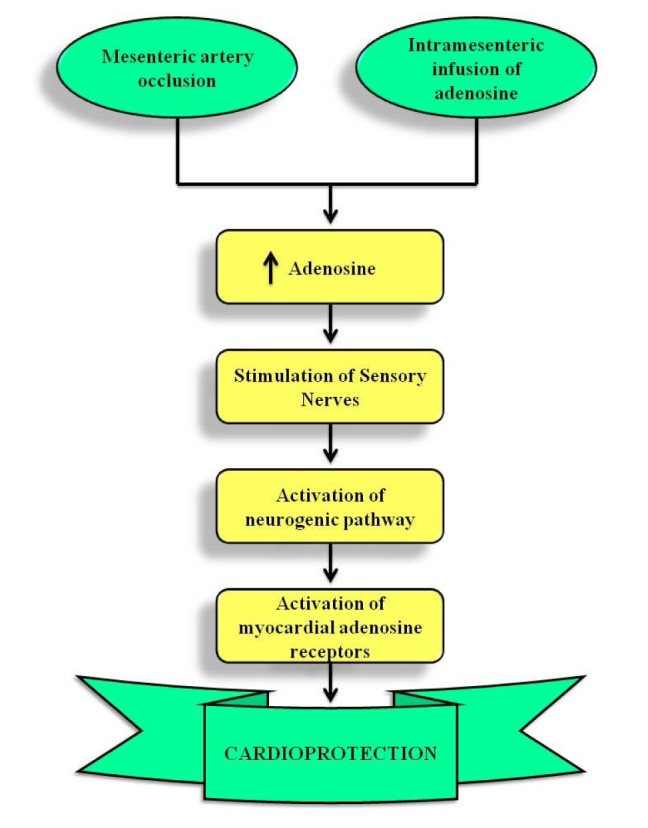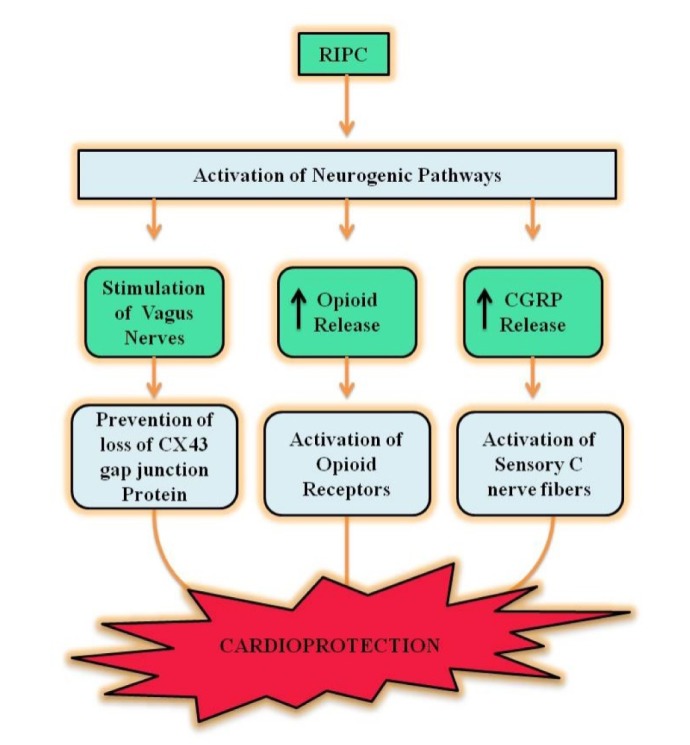Korean J Physiol Pharmacol.
2017 Mar;21(2):145-152. 10.4196/kjpp.2017.21.2.145.
Neurogenic pathways in remote ischemic preconditioning induced cardioprotection: Evidences and possible mechanisms
- Affiliations
-
- 1Department of Pharmaceutical Sciences and Drug Research, Punjabi University Patiala, Patiala 147002, India. amteshwarjaggi@yahoo.co.in
- KMID: 2371032
- DOI: http://doi.org/10.4196/kjpp.2017.21.2.145
Abstract
- Remote ischemic preconditioning (RIPC) is an intrinsic phenomenon whereby 3~4 consecutive ischemia-reperfusion cycles to a remote tissue (noncardiac) increases the tolerance of the myocardium to sustained ischemiareperfusion induced injury. Remote ischemic preconditioning induces the local release of chemical mediators which activate the sensory nerve endings to convey signals to the brain. The latter consequently stimulates the efferent nerve endings innervating the myocardium to induce cardioprotection. Indeed, RIPC-induced cardioprotective effects are reliant on the presence of intact neuronal pathways, which has been confirmed using nerve resection of nerves including femoral nerve, vagus nerve, and sciatic nerve. The involvement of neurogenic signaling has been further substantiated using various pharmacological modulators including hexamethonium and trimetaphan. The present review focuses on the potential involvement of neurogenic pathways in mediating remote ischemic preconditioning-induced cardioprotection.
MeSH Terms
Figure
Reference
-
1. Alhejily W, Aleksi A, Martin BJ, Anderson TJ. The effect of ischemia-reperfusion injury on measures of vascular function. Clin Hemorheol Microcirc. 2014; 56:265–271. PMID: 23719421.
Article2. Randhawa PK, Bali A, Jaggi AS. RIPC for multiorgan salvage in clinical settings: evolution of concept, evidences and mechanisms. Eur J Pharmacol. 2015; 746:317–332. PMID: 25176179.
Article3. Przyklenk K, Bauer B, Ovize M, Kloner RA, Whittaker P. Regional ischemic ‘preconditioning’ protects remote virgin myocardium from subsequent sustained coronary occlusion. Circulation. 1993; 87:893–899. PMID: 7680290.
Article4. Kant R, Diwan V, Jaggi AS, Singh N, Singh D. Remote renal preconditioning-induced cardioprotection: a key role of hypoxia inducible factor-prolyl 4-hydroxylases. Mol Cell Biochem. 2008; 312:25–31. PMID: 18273560.
Article5. Wang Y, Xu H, Mizoguchi K, Oe M, Maeta H. Intestinal ischemia induces late preconditioning against myocardial infarction: a role for inducible nitric oxide synthase. Cardiovasc Res. 2001; 49:391–398. PMID: 11164849.
Article6. Kharbanda RK, Mortensen UM, White PA, Kristiansen SB, Schmidt MR, Hoschtitzky JA, Vogel M, Sorensen K, Redington AN, MacAllister R. Transient limb ischemia induces remote ischemic preconditioning in vivo. Circulation. 2002; 106:2881–2883. PMID: 12460865.
Article7. Tokuno S, Hinokiyama K, Tokuno K, Löwbeer C, Hansson LO, Valen G. Spontaneous ischemic events in the brain and heart adapt the hearts of severely atherosclerotic mice to ischemia. Arterioscler Thromb Vasc Biol. 2002; 22:995–1001. PMID: 12067910.
Article8. Loukogeorgakis SP, Panagiotidou AT, Broadhead MW, Donald A, Deanfield JE, MacAllister RJ. Remote ischemic preconditioning provides early and late protection against endothelial ischemiareperfusion injury in humans: role of the autonomic nervous system. J Am Coll Cardiol. 2005; 46:450–456. PMID: 16053957.9. Candilio L, Malik A, Ariti C, Khan SA, Barnard M, Di Salvo C, Lawrence DR, Hayward MP, Yap JA, Sheikh AM, McGregor CG, Kolvekar SK, Hausenloy DJ, Yellon DM, Roberts N. A retrospective analysis of myocardial preservation techniques during coronary artery bypass graft surgery: are we protecting the heart? J Cardiothorac Surg. 2014; 9:184. PMID: 25551585.
Article10. Ali N, Rizwi F, Iqbal A, Rashid A. Induced remote ischemic preconditioning on ischemia-reperfusion injury in patients undergoing coronary artery bypass. J Coll Physicians Surg Pak. 2010; 20:427–431. PMID: 20642939.11. Lim SY, Yellon DM, Hausenloy DJ. The neural and humoral pathways in remote limb ischemic preconditioning. Basic Res Cardiol. 2010; 105:651–655. PMID: 20449597.
Article12. Hausenloy DJ, Yellon DM. Remote ischaemic preconditioning: underlying mechanisms and clinical application. Cardiovasc Res. 2008; 79:377–386. PMID: 18456674.
Article13. Gho BC, Schoemaker RG, van den Doel MA, Duncker DJ, Verdouw PD. Myocardial protection by brief ischemia in noncardiac tissue. Circulation. 1996; 94:2193–2200. PMID: 8901671.
Article14. Schoemaker RG, van Heijningen CL. Bradykinin mediates cardiac preconditioning at a distance. Am J Physiol Heart Circ Physiol. 2000; 278:H1571–H1576. PMID: 10775135.15. Ding YF, Zhang MM, He RR. Role of renal nerve in cardioprotection provided by renal ischemic preconditioning in anesthetized rabbits. Sheng Li Xue Bao. 2001; 53:7–12. PMID: 11354802.16. Liem DA, Verdouw PD, Ploeg H, Kazim S, Duncker DJ. Sites of action of adenosine in interorgan preconditioning of the heart. Am J Physiol Heart Circ Physiol. 2002; 283:H29–H37. PMID: 12063271.17. Wolfrum S, Schneider K, Heidbreder M, Nienstedt J, Dominiak P, Dendorfer A. Remote preconditioning protects the heart by activating myocardial PKCepsilon-isoform. Cardiovasc Res. 2002; 55:583–589. PMID: 12160956.18. Shimizu M, Tropak M, Diaz RJ, Suto F, Surendra H, Kuzmin E, Li J, Gross G, Wilson GJ, Callahan J, Redington AN. Transient limb ischaemia remotely preconditions through a humoral mechanism acting directly on the myocardium: evidence suggesting cross-species protection. Clin Sci (Lond). 2009; 117:191–200. PMID: 19175358.
Article19. Redington KL, Disenhouse T, Strantzas SC, Gladstone R, Wei C, Tropak MB, Dai X, Manlhiot C, Li J, Redington AN. Remote cardioprotection by direct peripheral nerve stimulation and topical capsaicin is mediated by circulating humoral factors. Basic Res Cardiol. 2012; 107:241. PMID: 22231674.
Article20. Wong GT, Lu Y, Mei B, Xia Z, Irwin MG. Cardioprotection from remote preconditioning involves spinal opioid receptor activation. Life Sci. 2012; 91:860–865. PMID: 22982345.
Article21. Jones WK, Fan GC, Liao S, Zhang JM, Wang Y, Weintraub NL, Kranias EG, Schultz JE, Lorenz J, Ren X. Peripheral nociception associated with surgical incision elicits remote nonischemic cardioprotection via neurogenic activation of protein kinase C signaling. Circulation. 2009; 120(11 Suppl):S1–S9. PMID: 19752352.
Article22. Donato M, Buchholz B, Rodríguez M, Pérez V, Inserte J, García-Dorado D, Gelpi RJ. Role of the parasympathetic nervous system in cardioprotection by remote hindlimb ischaemic preconditioning. Exp Physiol. 2013; 98:425–434. PMID: 22872660.
Article23. Katare RG, Ando M, Kakinuma Y, Arikawa M, Handa T, Yamasaki F, Sato T. Vagal nerve stimulation prevents reperfusion injury through inhibition of opening of mitochondrial permeability transition pore independent of the bradycardiac effect. J Thorac Cardiovasc Surg. 2009; 137:223–231. PMID: 19154929.
Article24. Kakinuma Y, Ando M, Kuwabara M, Katare RG, Okudela K, Kobayashi M, Sato T. Acetylcholine from vagal stimulation protects cardiomyocytes against ischemia and hypoxia involving additive non-hypoxic induction of HIF-1alpha. FEBS Lett. 2005; 579:2111–2118. PMID: 15811327.25. Oba T, Yasukawa H, Nagata T, Kyogoku S, Minami T, Nishihara M, Ohshima H, Mawatari K, Nohara S, Takahashi J, Sugi Y, Igata S, Iwamoto Y, Kai H, Matsuoka H, Takano M, Aoki H, Fukumoto Y, Imaizumi T. Renal nerve-mediated erythropoietin release confers cardioprotection during remote ischemic preconditioning. Circ J. 2015; 79:1557–1567. PMID: 25833080.
Article26. Diwan V, Jaggi AS, Singh M, Singh N, Singh D. Possible involvement of erythropoietin in remote renal preconditioning-induced cardioprotection in rats. J Cardiovasc Pharmacol. 2008; 51:126–130. PMID: 18287879.
Article27. Dong JH, Liu YX, Ji ES, He RR. Limb ischemic preconditioning reduces infarct size following myocardial ischemia-reperfusion in rats. Sheng Li Xue Bao. 2004; 56:41–46. PMID: 14985828.28. Jensen RV, Støttrup NB, Kristiansen SB, Bøtker HE. Release of a humoral circulating cardioprotective factor by remote ischemic preconditioning is dependent on preserved neural pathways in diabetic patients. Basic Res Cardiol. 2012; 107:285. PMID: 22821347.
Article29. Song Y, Ye YJ, Li PW, Zhao YL, Miao Q, Hou DY, Ren XP. The cardioprotective effects of late-phase remote preconditioning of trauma depends on neurogenic pathways and the activation of PKC and NF-κB (But Not iNOS) in mice. J Cardiovasc Pharmacol Ther. 2016; 21:310–319. PMID: 26450997.
Article30. Redington KL, Disenhouse T, Strantzas SC, Gladstone R, Wei C, Tropak MB, Dai X, Manlhiot C, Li J, Redington AN. Remote cardioprotection by direct peripheral nerve stimulation and topical capsaicin is mediated by circulating humoral factors. Basic Res Cardiol. 2012; 107:241. PMID: 22231674.
Article31. Vignaud A, Hourde C, Medja F, Agbulut O, Butler-Browne G, Ferry A. Impaired skeletal muscle repair after ischemia-reperfusion injury in mice. J Biomed Biotechnol. 2010; 2010:724914. PMID: 20467471.
Article32. Cheung MM, Kharbanda RK, Konstantinov IE, Shimizu M, Frndova H, Li J, Holtby HM, Cox PN, Smallhorn JF, Van Arsdell GS, Redington AN. Randomized controlled trial of the effects of remote ischemic preconditioning on children undergoing cardiac surgery: first clinical application in humans. J Am Coll Cardiol. 2006; 47:2277–2282. PMID: 16750696.33. Davies WR, Brown AJ, Watson W, McCormick LM, West NE, Dutka DP, Hoole SP. Remote ischemic preconditioning improves outcome at 6 years after elective percutaneous coronary intervention: the CRISP stent trial long-term follow-up. Circ Cardiovasc Interv. 2013; 6:246–251. PMID: 23696599.34. Deng QW, Xia ZQ, Qiu YX, Wu Y, Liu JX, Li C, Liu KX. Clinical benefits of aortic cross-clamping versus limb remote ischemic preconditioning in coronary artery bypass grafting with cardiopulmonary bypass: a meta-analysis of randomized controlled trials. J Surg Res. 2015; 193:52–68. PMID: 25456113.
Article35. Zarbock A, Schmidt C, Van Aken H, Wempe C, Martens S, Zahn PK, Wolf B, Goebel U, Schwer CI, Rosenberger P, Haeberle H, Görlich D, Kellum JA, Meersch M. Effect of remote ischemic preconditioning on kidney injury among high-risk patients undergoing cardiac surgery: a randomized clinical trial. JAMA. 2015; 313:2133–2141. PMID: 26024502.36. Robertson FP, Goswami R, Wright GP, Fuller B, Davidson BR. Protocol for a prospective randomized controlled trial of recipient remote ischaemic preconditioning in orthotopic liver transplantation (RIPCOLT trial). Transplant Res. 2016; 5:4. PMID: 27054029.
Article37. Wu J, Feng X, Huang H, Shou Z, Zhang X, Wang R, Chen Y, Chen J. Remote ischemic conditioning enhanced the early recovery of renal function in recipients after kidney transplantation: a randomized controlled trial. J Surg Res. 2014; 188:303–308. PMID: 24556231.38. Boengler K, Konietzka I, Buechert A, Heinen Y, Garcia-Dorado D, Heusch G, Schulz R. Loss of ischemic preconditioning's cardioprotection in aged mouse hearts is associated with reduced gap junctional and mitochondrial levels of connexin 43. Am J Physiol Heart Circ Physiol. 2007; 292:H1764–H1769. PMID: 17142336.
Article39. Abete P, Ferrara N, Cioppa A, Ferrara P, Bianco S, Calabrese C, Cacciatore F, Longobardi G, Rengo F. Preconditioning does not prevent postischemic dysfunction in aging heart. J Am Coll Cardiol. 1996; 27:1777–1786. PMID: 8636568.
Article40. Vasile VC, Babuin L, Giannitsis E, Katus HA, Jaffe AS. Relationship of MRI-determined infarct size and cTnI measurements in patients with ST-elevation myocardial infarction. Clin Chem. 2008; 54:617–619. PMID: 18310155.
Article41. Longobardi G, Abete P, Ferrara N, Papa A, Rosiello R, Furgi G, Calabrese C, Cacciatore F, Rengo F. “Warm-up” phenomenon in adult and elderly patients with coronary artery disease: further evidence of the loss of “ischemic preconditioning” in the aging heart. J Gerontol A Biol Sci Med Sci. 2000; 55:M124–M129. PMID: 10795723.
Article42. Ishihara M, Sato H, Tateishi H, Kawagoe T, Shimatani Y, Ueda K, Noma K, Yumoto A, Nishioka K. Beneficial effect of prodromal angina pectoris is lost in elderly patients with acute myocardial infarction. Am Heart J. 2000; 139:881–888. PMID: 10783223.
Article43. Jensen RV, Zachara NE, Nielsen PH, Kimose HH, Kristiansen SB, Bøtker HE. Impact of O-GlcNAc on cardioprotection by remote ischaemic preconditioning in non-diabetic and diabetic patients. Cardiovasc Res. 2013; 97:369–378. PMID: 23201773.
Article44. Lee JH, Park YH, Byon HJ, Kim HS, Kim CS, Kim JT. Effect of remote ischaemic preconditioning on ischaemic-reperfusion injury in pulmonary hypertensive infants receiving ventricular septal defect repair. Br J Anaesth. 2012; 108:223–228. PMID: 22157844.
Article45. Loubani M, Fowler A, Standen NB, Galiñanes M. The effect of gliclazide and glibenclamide on preconditioning of the human myocardium. Eur J Pharmacol. 2005; 515:142–149. PMID: 15894305.
Article46. Kottenberg E, Musiolik J, Thielmann M, Jakob H, Peters J, Heusch G. Interference of propofol with signal transducer and activator of transcription 5 activation and cardioprotection by remote ischemic preconditioning during coronary artery bypass grafting. J Thorac Cardiovasc Surg. 2014; 147:376–382. PMID: 23465551.
Article
- Full Text Links
- Actions
-
Cited
- CITED
-
- Close
- Share
- Similar articles
-
- Mechanisms and Prospects of Ischemic Tolerance Induced by Cerebral Preconditioning
- Mechanisms involved in adenosine pharmacological preconditioning-induced cardioprotection
- Role of Protein Kinase C Signaling in Intestinal Ischemic Preconditioning
- Conditioning-induced cardioprotection: Aging as a confounding factor
- Protective effect of combination therapy with ischemic preconditioning and rapamycin in fibrotic rat livers



